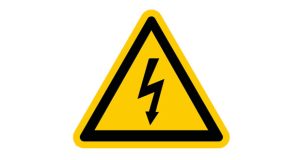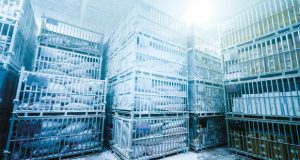 Kevin Belben, Technical Applications Manager at water management specialists Cistermiser and Keraflo, discusses the potential for data management in the latest water temperature monitoring systems and how harnessing The Internet of Things is helping improve end user safety and estate efficiency.
Kevin Belben, Technical Applications Manager at water management specialists Cistermiser and Keraflo, discusses the potential for data management in the latest water temperature monitoring systems and how harnessing The Internet of Things is helping improve end user safety and estate efficiency.
Water quality and sustainability may not be the most exciting of topics to talk about, but it doesn’t get much more serious. The consequences of poor water management, especially in larger buildings such as office blocks, schools, universities and hospitals, is not to be ignored. Legionella bacteria can develop in water if the temperature is not within the safe zone. The bacterium will proliferate between 20°C and 45°C so keeping the temperature out of this danger zone is essential (“Keep your hot water Hot and your cold water Cold”). Essential, but not easy, especially in large and complex environments.
Existing water temperature monitoring solutions usually consist of manual checks which are time-consuming and involve wasteful water-flushing. However, one of the biggest problems faced by facilities managers is a lack of data. If there is a shortage of accurate data to hand, it is almost impossible to identify that water temperatures are out of range across a large-scale building which may have hundreds or even thousands of water system outlets to monitor. Despite its critical function, water management in large-scale estates has traditionally been perceived as a problem-child.
While facilities managers are good at undertaking risk assessments and addressing the need for water monitoring, many face resource issues that make it difficult to ensure the necessary laborious manual checks happen as often as they should. It’s not a lack of willingness or ability, just the sheer scale of the job when done manually. You need the manpower to visit all required areas of the estate and flush under-utilised outlets, take temperature readings using a probe or thermistor at sentinel points each month, or perhaps on an more regular basis depending on the risk assessment, record the data, and then email or manually input the data into whatever collation method the organisation is using, such as an electronic log-book. This could mean there are thousands of temperature readings to sort through, analyse, and, where necessary, respond to with remedial action each week. Not only is this strategy open to human error, but inordinate amounts of time are spent by staff who could be otherwise more valuably engaged.
Harnessing the Internet of Things
The latest innovation that’s already changing how facilities managers are managing water systems, is an operating system comprising physical hardware connected to a cloud-based IoT portal. Intelligent temperature monitoring units deliver automatic wireless monitoring, providing real-time temperature readings on a computer screen, in order to track and monitor hot and cold water temperatures in pipework systems – critical to risk assessments.
A connected temperature monitoring unit can be retrofittable, and is fitted onto water outlet pipework, distribution pipework including risers, calorifiers, cold water storage tanks and many other parts of your water system.
The unit takes a reading every ten seconds, and then sends temperature and flow event data to the cloud on an hourly basis. Recorded data includes maximum, minimum and average temperatures. The sensor also records any flow events, such as outlets being utilised. The data readings are analysed by the device’s inbuilt software, batched and sent up back to the cloud, and then on to the user’s preferred interface which might be a phone, tablet or PC.
Knowledge is power
The power of the data generated by such systems is where facilities managers will really start to see the benefits. A good temperature monitoring system is an excellent way of efficiently managing the necessary data for any legislative requirements, but it can go way beyond this too. It also offers previously inaccessible information in real time, and for those who want to really maximise use of the data, reports can be set up to indicate how water is (or isn’t) being used in specific areas and extrapolating this one step further, user behaviour can be profiled to deploy optimal resource solutions. For example, if a report shows that most of the activations of a particular thermostatic valve are early in the morning or early evening, this may give facilities managers a good idea on when to send cleaners in or schedule water quality sampling at appropriate times.
In a world where data is becoming increasingly valuable, advanced temperature monitoring systems are the ideal solution for facilities managers in all kinds of buildings. However, they also harness a hidden benefit which FMs may find surprising. When you have so much data at your fingertips on a day to day basis, a lack of data can tell as much of a story as the data itself. For example, if the hand basins in a particular care establishment or hospital ward aren’t being used very much – if there is a lack of outlet utilisation – the lack of use will be alerted to the ward to ensure that patient care policies around hand washing, etc, are being followed. If there is a lack of data in a particular washroom in an office block that suggests it is being used less than other washrooms in the building, the housekeeping schedules can be reviewed and the team can be deployed more effectively.
 Proactive alerts and ongoing maintenance
Proactive alerts and ongoing maintenance
The majority of users will want the system set-up to alert if there is a problem, then send an alarm notification as appropriate. At any juncture users and managers can see how many outlets are being monitored, how many are presenting no risk, a ‘high’, ‘medium’, or ‘low’ risk, temperature or flow-wise, and which are functioning optimally. By clicking on screen where an issue is identified, the user receives a summary of what the issues are. You can, for example, easily bring up a list of all outlets where temperatures or water flows are presenting a potential risk.
A user might also want to log in monthly and export a report which will give a summary of all activity for the last month. The range of temperatures can also be illustrated via a colour-coded graph. Once the data is recorded it can be integrated into an organisation’s CAFM, compliance software system or exported as required.
A new way
IoT water monitoring is a completely new way of thinking, so it won’t become universally adopted overnight, but trends indicate that use of the cloud is becoming mainstream. With safety, efficiency, cost reduction and evidencing all key priorities for FMs across all sectors, the benefits of remote water monitoring solutions indicate that more and better data will be the future of water system management.





